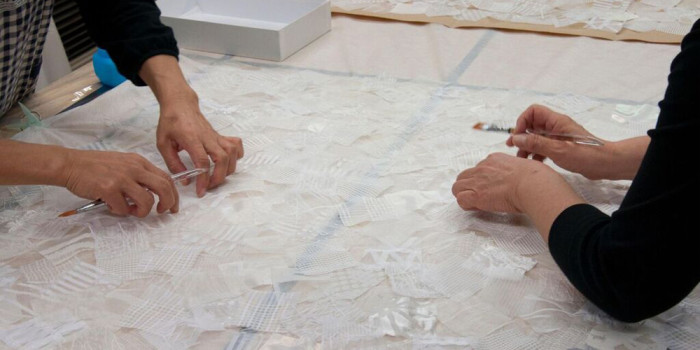Tsugihagi was designed by Reiko Sudo (b. 1953), one of Japan’s most important contemporary textile designers. Educated at Musashino Art University, she is currently managing director of the Japanese company and store NUNO where she has been since 1984. NUNO produces textiles of extraordinary ingenuity and beauty. Sudo and the other designers at NUNO combine tradition and advanced technologies with remarkable creativity, which led them to the forefront of textile design field.

Tsuhihagi layout. Courtesy of Nuno.
In 1996, NUNO began working with various kinds of embroidery techniques to create new effects. Tsugihagi, designed in 1997, is a delicate combination of embroidery and collage techniques made with remnants of NUNO fabrics that are laid out to cover the surface of a base fabric. The remnants are stitched down by sewing machine, and the base fabric is dissolved away leaving a lacy and net-like patchwork of different fabrics. Each piece is unique and twenty years later they continue to produce these textiles. Tsugihagi can be used as a window covering or for other interior purposes. This type of embroidery technique, in which the ground fabric is destroyed, began in the early 1880s when protein fibers like silk or wool were more than likely used because they could be dissolved by a solution of caustic soda or potash, leaving the embroidery thread of cellulose fibers like cotton or linen intact.
About the Author
Matilda McQuaid is the Deputy Director of Curatorial and Head of Textiles at Cooper Hewitt, Smithsonian Design Museum.
Scraps Stories
This post is part of the blog series Scraps Stories dedicated to exploring sustainable textiles and fashion, in relation to the exhibition Scraps: Fashion, Textiles, and Creative Reuse.
